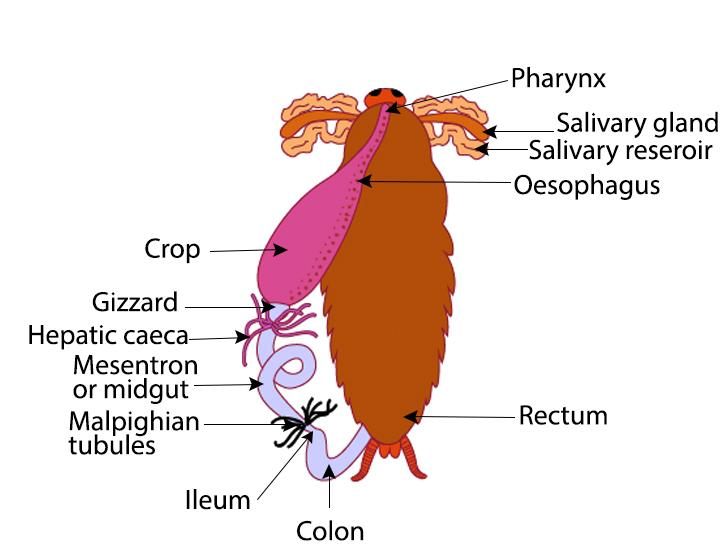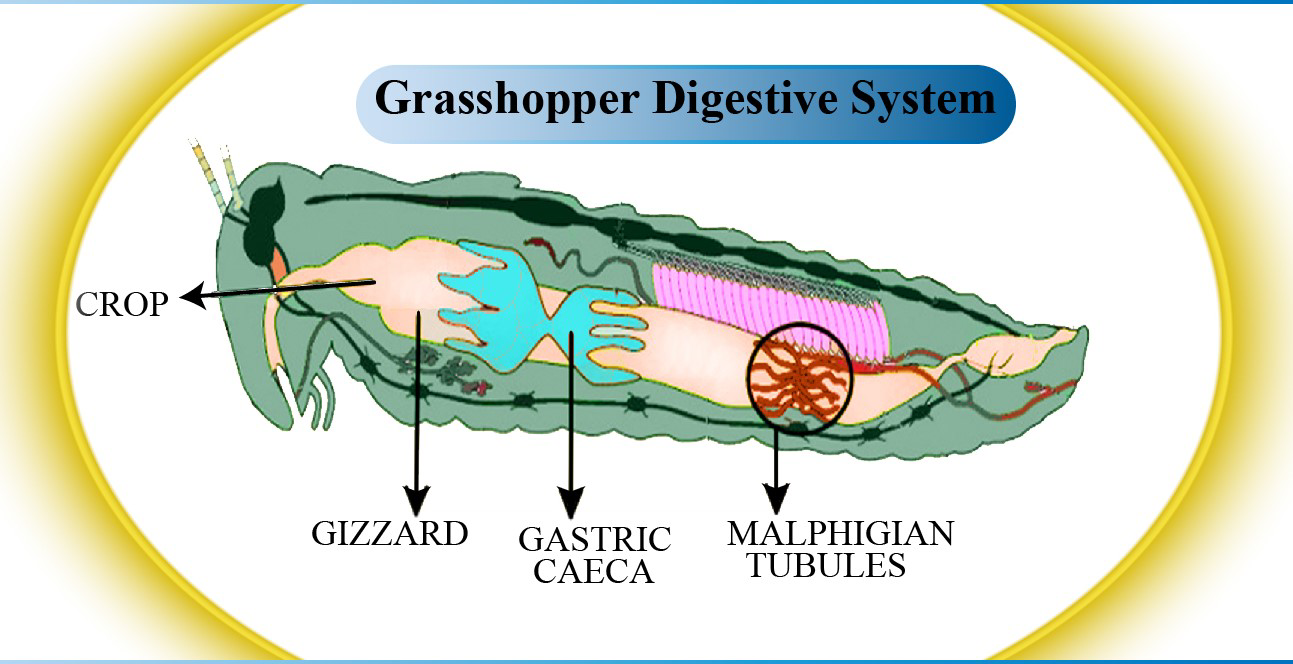
The function of the gizzard seen in grasshopper and cockroach digestive system is
A. Removal of excretory products
B. Storage of food materials
C. Grinding of food materials
D. Secretion of digestive enzymes
Answer
576.9k+ views
Hint: Gizzard is a thick-walled muscular organ that has functions similar to the human stomach. It is also seen in birds. It contains structures which mainly helps in increasing the surface area of the food so that enzymes can act efficiently.
Complete answer:
The gizzard is an oval, muscular, and thick-walled structural organs. It bears six chitinous ridges on which teeth like structures are present which help in grinding and churning of the food. It converts the food into a fine semisolid state.
The gizzard is modified in different insects depending upon requirements. It may be teeth like plate-like or spine-like.
Additional Information:
The digestive system of insects has the following parts and features:
Foregut: It is internally lined by the cuticle. It includes the mouthparts which lead to a preoral cavity known as a cibarium. Behind the mouth muscular pharynx is present. The pharynx acts as a pump and food from the pharynx passes into the esophagus. From the esophagus, food passes into the crop where it is stored.
In honey bees, the crop is known as a honey stomach where conversion of nectar to honey takes place.
Gizzard in the next part and is also known as proventriculus.
Midgut: It is known as the mesenteron. It consists of secretory epithelial cells and regenerative cells. The insides of the midgut are lined by a membrane known as the peritrophic membrane. Components of the midgut include gastric caecae, pyloric valve, and filter chamber.
Hindgut: Its main function is the absorption of water and minerals.
So, the correct answer is, ‘the function of gizzard seen in grasshopper and cockroach digestive systems is grinding of food materials’.
Note: The main function of the gizzard is grinding the food and not storage. Food is stored in the crop which is the structure just before the gizzard in the digestive system of insects. Also, the structure of chitinous plates varies in the gizzards of different insects.


Complete answer:
The gizzard is an oval, muscular, and thick-walled structural organs. It bears six chitinous ridges on which teeth like structures are present which help in grinding and churning of the food. It converts the food into a fine semisolid state.
The gizzard is modified in different insects depending upon requirements. It may be teeth like plate-like or spine-like.
Additional Information:
The digestive system of insects has the following parts and features:
Foregut: It is internally lined by the cuticle. It includes the mouthparts which lead to a preoral cavity known as a cibarium. Behind the mouth muscular pharynx is present. The pharynx acts as a pump and food from the pharynx passes into the esophagus. From the esophagus, food passes into the crop where it is stored.
In honey bees, the crop is known as a honey stomach where conversion of nectar to honey takes place.
Gizzard in the next part and is also known as proventriculus.
Midgut: It is known as the mesenteron. It consists of secretory epithelial cells and regenerative cells. The insides of the midgut are lined by a membrane known as the peritrophic membrane. Components of the midgut include gastric caecae, pyloric valve, and filter chamber.
Hindgut: Its main function is the absorption of water and minerals.
So, the correct answer is, ‘the function of gizzard seen in grasshopper and cockroach digestive systems is grinding of food materials’.
Note: The main function of the gizzard is grinding the food and not storage. Food is stored in the crop which is the structure just before the gizzard in the digestive system of insects. Also, the structure of chitinous plates varies in the gizzards of different insects.


Recently Updated Pages
Master Class 11 Economics: Engaging Questions & Answers for Success

Master Class 11 English: Engaging Questions & Answers for Success

Master Class 11 Social Science: Engaging Questions & Answers for Success

Master Class 11 Biology: Engaging Questions & Answers for Success

Class 11 Question and Answer - Your Ultimate Solutions Guide

Master Class 11 Business Studies: Engaging Questions & Answers for Success

Trending doubts
10 examples of friction in our daily life

One Metric ton is equal to kg A 10000 B 1000 C 100 class 11 physics CBSE

Difference Between Prokaryotic Cells and Eukaryotic Cells

1 Quintal is equal to a 110 kg b 10 kg c 100kg d 1000 class 11 physics CBSE

Explain zero factorial class 11 maths CBSE

What is a periderm How does periderm formation take class 11 biology CBSE




